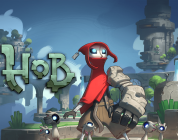Fantasy stories have had their fill of the stereotypical creatures and heroes. Elves, orcs, mages, dwarves, warriors, kings, fairies — they’re all a dime a dozen. Similarly, the stories of Greek and Roman gods have been told and retold over and over again. But before playing Mulaka, I had never heard of the Tarahumara, an indigenous people of northwestern Mexico renowned for their long-distance running ability. Being introduced to that culture via this imaginative 3D action-adventure proved there are still new and rich fantasy worlds out there to explore.
Playing as a Sukurúame, a Tarahumara shaman, you’ll run from village to village to defeat mythological monsters that strike fear into the locals. Villagers will often help point you in the right direction should you become lost. Each encounter with a demigod ally creates a story-around-the-campfire feel through voiceovers in the Tarahumara’s indigenous language during each cutscene—cutscenes that are beautifully animated with black and white hand drawings, sometimes with a splash of color. This style differs from the low-poly, whimsical style that makes up the majority of Mulaka, but is no less visually striking. With such interesting mythology driving Mulaka’s story during these cutscenes though, it surprised me that a stronger focus wasn’t put on the story’s mythology outside of the cutscenes and enemies.
You’ll get snippets of information about your role as a Sukurúame within society from the locals, but it’s nothing you won’t already know from watching the opening cutscene. The conversations with other characters are all one-sided. You, the powerful Tarahumara shaman, are the brooding, silent type. Villagers will talk at you, you’ll automatically respond with an ellipsis if a villager asks you a question, and then they’ll repeat what you supposedly said even though you didn’t say anything. These bland character interactions caused me to barrel through one village to the next, hardly ever stopping to “chat.” Your character has no personality, and the feelings toward your character from the villagers rarely go deeper than “Hi, save us from these creatures.”
Some of the dialogue also felt out of place—several centuries out of place. While many of the characters’ dialogue was natural and slang-free, words like ‘gonna’ popped up every so often. The modern dialect juxtaposed with the ancient visuals was weird. Other bits of dialogue felt like filler just to have a character say something. “Dum, dum, dum, I love my drum,” said one village musician. There is one recurring character, a zoologist of sorts with an exotic bird perched on each shoulder, who is one of the most well-rounded characters of Mulaka; they aren’t shy about sharing their love of studying strange creatures. They had the kind of depth to their personality I wanted from the Sukurúame.
Tarahumara mythology is inserted into every aspect of the gameplay: the landscape, the mechanics, the enemies, the bosses. The Rusíwari are soul-eating rocks that look like a cross between a tapeworm and a piranha. They appear virtually invisible at first, but you can see them by activating your Sukurúame vision. They may be easy to defeat, but they can easily sneak up on you and steal one of your souls. Luckily, you have a couple of souls to spare—a total of three, as the Tarahumara people believe. Each soul can sustain several hits before it leaves your body entirely, but you can get a soul back and restore all of its health by consuming one aloe potion or more depending on how badly you are damaged.
Healing yourself in the middle of a fight can be frustrating though. Your character will dance in place for two or three seconds before being able to re-engage in the fight, leaving himself vulnerable to attacks. Depending on when you trigger the healing potion, it may or may not take effect before something has a chance to swipe at you. If something hits you before the soul re-enters your body, you’ll lose more health and will have wasted an aloe potion.
With a character traditionally known for their running prowess, sprinting is not a focus in Mukala; there is no fatigue bar, so you can sprint for as long as you want, but it’s a basic ability that is overshadowed by the shapeshifting powers given to you by the demigods. With this ability, you can shapeshift into four different creatures. So, whether you are flying around as a woodpecker, bashing boulders as a bear, scaling rock walls as a puma, or slinking your way through a river as a snake, the shapeshifting abilities help you reach inaccessible areas where something crucial to your journey could be hiding. This shape-shifting ability didn’t become stale, because there was a variety of places and situations where you could use them, environmental and combat alike.
Shapeshifting will also help you defeat some bosses and enemies, but it doesn’t add much variety to the predictable and repetitive combat overall. I’m not one for arena fights for this reason; if the combat isn’t challenging, and if there isn’t much of a story to fall back on, my attention wanes. Mulaka has several arena fights in each level prior to the boss, and after a short period of time the same enemies start to appear in each one. It’s easy to figure out how to defeat every enemy and every boss, so Mulaka isn’t challenging in that regard. I had a harder time flying across a ravine than taking down a huge rock monster. Each level follows the same formula: kill stuff, get special stones to unlock boss, fight boss, move on to a new level. After doing that for over 15 hours, I was beyond ready to move on to something else.
The nuts and bolts of the mechanics I expected to be more cumbersome than they were. Movement, combat, and shapeshifting utilize different combinations of the same keys, but there were few moments where I found myself accidentally turning in a bear when I wanted to use my strong slash attack on a giant toad—right mouse button triggers both, but tapping the button causes the slash, while holding the button transforms you into a bear. In the same vein, spacebar allows you to jump, but double tapping it turns you into a woodpecker, while tapping spacebar and mouse wheel at the same time transform you into a puma. I appreciated that Mulaka didn’t force my tiny fingers to stretch and bend all over the keyboard like some sadistic form of Twister.
Tarahumara mythology is fascinating—just the break I needed away from the Skyrims and World of Warcrafts of the fantasy genre. I might never have learned about the Tarahumara and listened to an indigenous language for the first time. But, Mulaka stretches a bit too long for my taste. The story is fragmented by repetitive and predictable combat, and there’s not a whole lot of meaningful interaction with other characters. With so much beauty in Mulaka between the cutscenes and village landscapes, it’s unfortunate that those elements were dwarfed against issues with the combat and story.
A copy of the game was provided by the developer.









